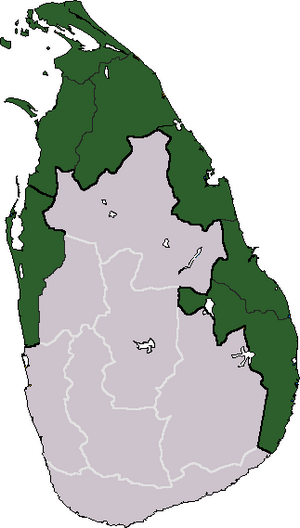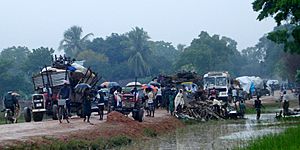Sri Lankan Civil War facts for kids
Quick facts for kids Sri Lankan Civil Warශ්රී ලාංකික සිවිල් යුද්ධය இலங்கை உள்நாட்டுப் போர் |
|||||||||
|---|---|---|---|---|---|---|---|---|---|
|
The area of Sri Lanka claimed by the LTTE as Tamil Eelam, where the vast majority of the fighting took place |
|||||||||
|
|||||||||
| Belligerents | |||||||||
|
|
|||||||||
| Commanders and leaders | |||||||||
|
|
|||||||||
| Strength | |||||||||
|
100,000 (peak) |
(excluding Auxiliary forces): 6,000 (2001) 7,000 (2003) 18,000 (2004) 11,000 (2005) 8,000 (2006) 7,000 (2007) (including Auxiliary forces): 25,000 (2006) 30,000 (2008) |
||||||||
| Casualties and losses | |||||||||
|
40,107 wounded |
27,000+ killed 11,644 captured |
||||||||
| 80,000-100,000 killed overall (estimate) 800,000 displaced at peak in 2001 |
|||||||||
| 16 May 2009: Sri Lankan Government declared a military defeat of LTTE. 17 May 2009: LTTE admit defeat by Sri Lankan Government. 19 May 2009: President Mahinda Rajapaksa officially declares end of civil war in parliament. |
|||||||||
The Sri Lankan Civil War was a long war that happened in the island country of Sri Lanka. It began on July 23, 1983. The war involved the Sri Lankan government fighting against a group called the Liberation Tigers of Tamil Eelam (LTTE), also known as the Tamil Tigers. This group was a separatist organization. They wanted to create an independent state for Tamil people in the northern and eastern parts of Sri Lanka. This proposed state was called Tamil Eelam.
The conflict lasted for 26 years. The Sri Lankan military finally defeated the Tamil Tigers in May 2009.
Contents
What Caused the Conflict?
The civil war in Sri Lanka had deep roots. It came from disagreements between the two main ethnic groups in the country. These groups are the Sinhalese and the Tamils. The Sinhalese are the majority group. They mostly follow Buddhism. The Tamils are a minority group. They mostly follow Hinduism.
After Sri Lanka became independent from British rule, there were laws that many Tamils felt were unfair. These laws favored the Sinhalese language and culture. This made many Tamils feel like they were treated as second-class citizens. Over time, these feelings of unfairness grew. Some Tamil groups started to demand their own separate state.
Who Were the Tamil Tigers?
The Liberation Tigers of Tamil Eelam (LTTE) was a powerful militant group. They were formed to fight for an independent Tamil state. Their leader was Velupillai Prabhakaran. The group was known for its strong military tactics. They also used methods that many countries considered terrorism.
The Tamil Tigers had their own army, navy (called Sea Tigers), and even a small air force. They controlled large areas in the north and east of Sri Lanka for many years. They were one of the most organized rebel groups in the world.
Key Events of the War
The war had several phases. It started with small attacks and grew into a full-scale conflict.
Indian Peacekeeping Force
From 1987 to 1990, the Indian Peace Keeping Force (IPKF) was involved. India sent its troops to Sri Lanka. This was to help bring peace and make sure an agreement was followed. However, the IPKF ended up fighting against the Tamil Tigers. They later left Sri Lanka.
Peace Talks and Renewed Fighting
There were several attempts to have peace talks. Both sides tried to find a way to end the war. However, these talks often failed. Fighting would start again after short periods of peace. A ceasefire agreement was signed in 2002. This brought a temporary stop to the fighting. But it broke down in 2006.
End of the War
In 2006, the Sri Lankan government launched a major military campaign. Their goal was to defeat the Tamil Tigers completely. The fighting was very intense. The government forces slowly took back control of the areas held by the LTTE.
By May 2009, the Sri Lankan military had cornered the remaining Tamil Tiger fighters. The leader, Velupillai Prabhakaran, was killed. On May 18, 2009, the Tamil Tigers admitted defeat. The next day, the President of Sri Lanka, Mahinda Rajapaksa, officially announced the end of the civil war.
Impact of the War
The civil war had a huge impact on Sri Lanka.
- Lives Lost: It is estimated that between 80,000 and 100,000 people died during the conflict. This includes soldiers, fighters, and many civilians.
- Displacement: Hundreds of thousands of people were forced to leave their homes. They became internally displaced persons (IDPs). Many lived in special camps for years.
- Damage: The war caused a lot of damage to buildings and infrastructure. Especially in the northern and eastern parts of the country.
- Economy: The war also affected Sri Lanka's economy. It made it harder for the country to grow and develop.
After the war, Sri Lanka began the process of rebuilding. Efforts were made to help displaced people return home. The country also worked towards healing the divisions between its ethnic groups.
Images for kids
-
Improvised armoured bulldozer used by the LTTE in the operation Aakaya Kadal Veli, also known as the First Battle of Elephant Pass (1991), one of the major battles. This bulldozer was destroyed by Cpl. Gamini Kularatne. Today it stands on display as a war memorial.
-
Canadian Tamils block University Avenue, Toronto demonstrating against the Sri Lankan forces.
See also
 In Spanish: Guerra civil de Sri Lanka para niños
In Spanish: Guerra civil de Sri Lanka para niños











